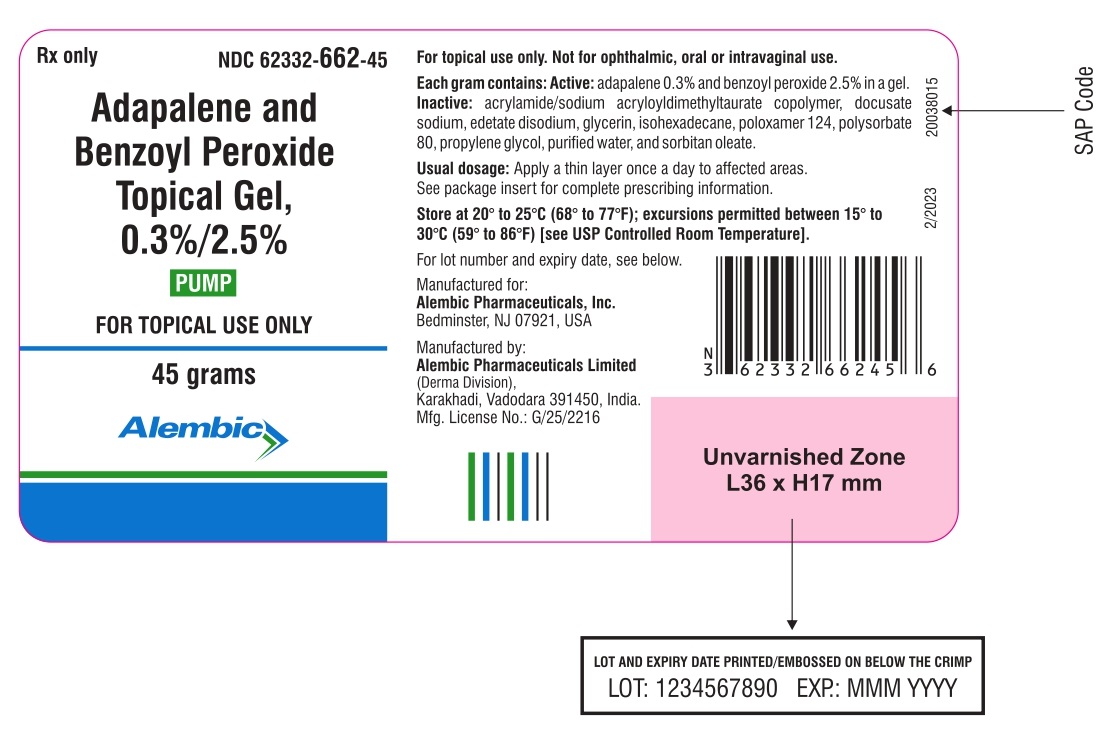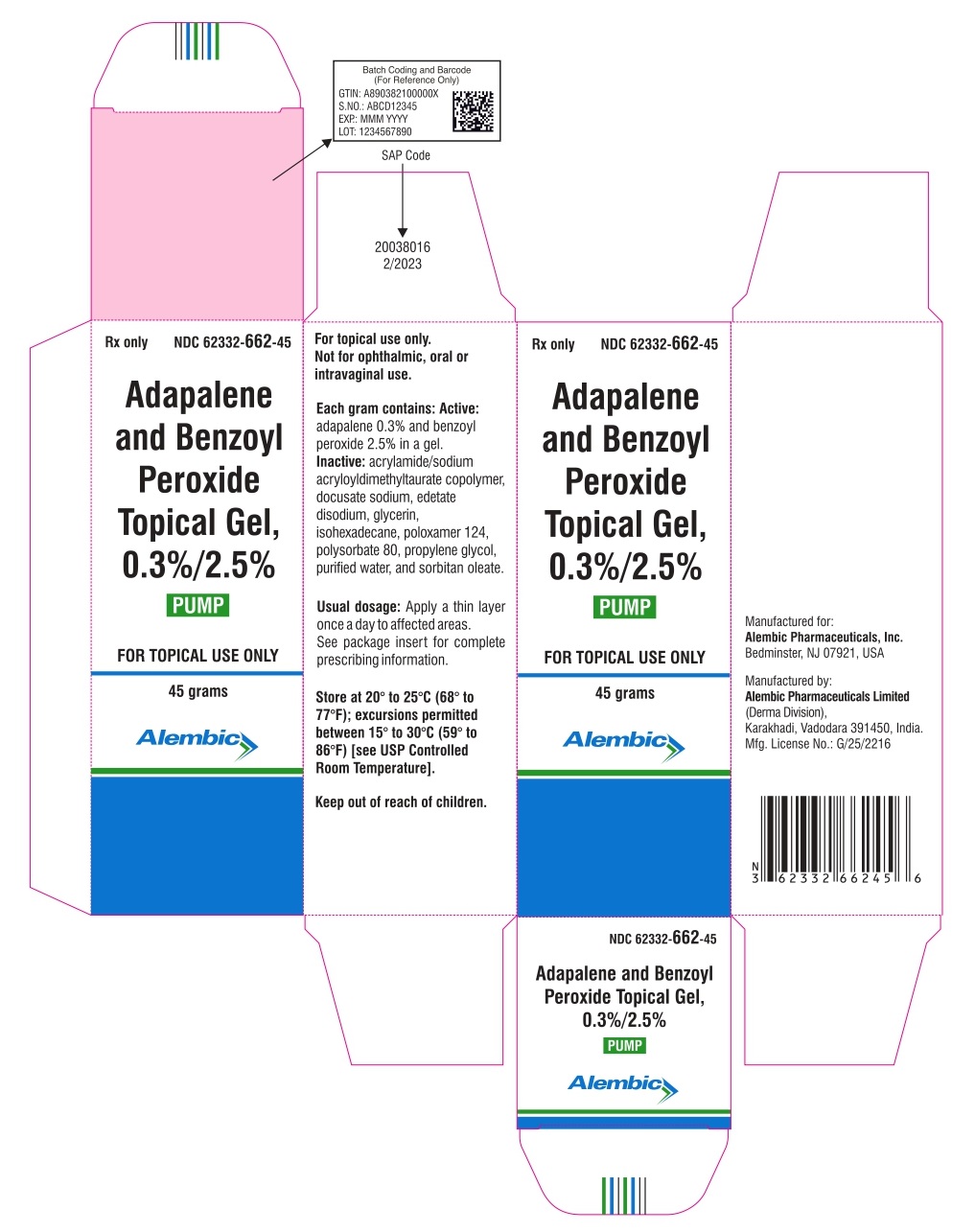Label: ADAPALENE AND BENZOYL PEROXIDE- adapalene and benzoyl peroxide topical gel
- NDC Code(s): 62332-662-45
- Packager: Alembic Pharmaceuticals Inc.
- Category: HUMAN PRESCRIPTION DRUG LABEL
Drug Label Information
Updated December 11, 2023
If you are a healthcare professional or from the pharmaceutical industry please visit this version.
- Download DRUG LABEL INFO: PDF XML
- Official Label (Printer Friendly)
-
HIGHLIGHTS OF PRESCRIBING INFORMATION
These highlights do not include all the information needed to use ADAPALENE AND BENZOYL PEROXIDE TOPICAL GEL safely and effectively. See full prescribing information for ADAPALENE AND BENZOYL PEROXIDE TOPICAL GEL.
ADAPALENE AND BENZOYL PEROXIDE topical gel
Initial U.S. Approval: 2015INDICATIONS AND USAGE
Adapalene and benzoyl peroxide topical gel, is a combination of adapalene, a retinoid, and benzoyl peroxide and is indicated for the topical treatment of acne vulgaris in adults and pediatric patients 12 years of age and older. (1)
DOSAGE AND ADMINISTRATION
- For topical use only
- Adapalene and benzoyl peroxide topical gel is not for oral, ophthalmic or intravaginal use. (2)
- Apply a thin layer of adapalene and benzoyl peroxide topical gel to affected areas of the face and/or trunk once daily after washing. (2)
- Use a pea-sized amount for each area of the face (e.g., forehead, chin, each cheek). (2)
- Avoid the eyes, lips, and mucous membranes. (2)
DOSAGE FORMS AND STRENGTHS
Topical Gel, 0.3%/2.5%. (3)
CONTRAINDICATIONS
Adapalene and benzoyl peroxide topical gel is contraindicated in patients with a history of hypersensitivity reactions to benzoyl peroxide or any components of the formulation in adapalene and benzoyl peroxide topical gel. (4)
WARNINGS AND PRECAUTIONS
- Hypersensitivity: Severe hypersensitivity reactions, including anaphylaxis and angioedema, have been reported with the use of benzoyl peroxide products. (5.1)
- Photosensitivity: Avoid exposure to sunlight and sunlamps. Wear broad spectrum sunscreen and protective clothing when sun exposure cannot be avoided. (5.2)
- Skin Irritation: Erythema, scaling, dryness, stinging/burning, irritant and allergic contact dermatitis may occur with use of adapalene and benzoyl peroxide topical gel and may necessitate discontinuation. (5.3)
ADVERSE REACTIONS
The most common adverse reactions (incidence ≥1%) are skin irritation, eczema, atopic dermatitis and skin burning sensation. (6)
To report SUSPECTED ADVERSE REACTIONS, contact Alembic Pharmaceuticals, Inc. at 1-866-210-9797 or FDA at 1-800-FDA-1088 or www.fda.gov/medwatch.
See 17 for PATIENT COUNSELING INFORMATION and FDA-approved patient labeling.
Revised: 12/2023
-
Table of Contents
FULL PRESCRIBING INFORMATION: CONTENTS*
1 INDICATIONS AND USAGE
2 DOSAGE AND ADMINISTRATION
3 DOSAGE FORMS AND STRENGTHS
4 CONTRAINDICATIONS
5 WARNINGS AND PRECAUTIONS
5.1 Hypersensitivity
5.2 Photosensitivity
5.3 Skin Irritation and Contact Dermatitis
6 ADVERSE REACTIONS
6.1 Clinical Trials Experience
6.2 Postmarketing Experience
8 USE IN SPECIFIC POPULATIONS
8.1 Pregnancy
8.2 Lactation
8.4 Pediatric Use
8.5 Geriatric Use
11 DESCRIPTION
12 CLINICAL PHARMACOLOGY
12.1 Mechanism of Action
12.2 Pharmacodynamics
12.3 Pharmacokinetics
13 NONCLINICAL TOXICOLOGY
13.1 Carcinogenesis, Mutagenesis, Impairment of Fertility
14 CLINICAL STUDIES
16 HOW SUPPLIED/STORAGE AND HANDLING
16.1 How Supplied
16.2 Storage and handling
17 PATIENT COUNSELING INFORMATION
- *
- Sections or subsections omitted from the full prescribing information are not listed.
- 1 INDICATIONS AND USAGE
-
2 DOSAGE AND ADMINISTRATION
- For topical use only. Adapalene and benzoyl peroxide topical gel is not for oral, ophthalmic, or intravaginal use.
- Apply a thin layer of adapalene and benzoyl peroxide topical gel to affected areas of the face and/or trunk once daily after washing.
- Use a pea-sized amount for each area of the face (e.g., forehead, chin, each cheek).
- Wash hands after application as adapalene and benzoyl peroxide topical gel may bleach hair or colored fabrics.
- Avoid the eyes, lips and mucous membranes.
- 3 DOSAGE FORMS AND STRENGTHS
- 4 CONTRAINDICATIONS
-
5 WARNINGS AND PRECAUTIONS
5.1 Hypersensitivity
Hypersensitivity reactions, including anaphylaxis, angioedema, and urticaria, have been reported with the use of benzoyl peroxide products. If a serious hypersensitivity reaction occurs, discontinue adapalene and benzoyl peroxide topical gel immediately and initiate appropriate therapy.
5.2 Photosensitivity
Avoid exposure to sunlight, including sunlamps, during the use of adapalene and benzoyl peroxide topical gel. Patients with high levels of sun exposure and those with inherent sensitivity to sun should exercise particular caution. Use of broad spectrum sunscreen products and protective apparel (e.g., hat) are recommended when exposure cannot be avoided. Weather extremes, such as wind or cold, may be irritating to patients under treatment with adapalene and benzoyl peroxide topical gel.
5.3 Skin Irritation and Contact Dermatitis
Erythema, scaling, dryness, and stinging/burning may be experienced with use of adapalene and benzoyl peroxide topical gel. These are most likely to occur during the first four weeks of treatment, are mostly mild to moderate in intensity, and usually lessen with continued use of the medication. Irritant and allergic contact dermatitis may occur. Depending upon the severity of these adverse reactions, patients should be instructed to use a moisturizer, reduce the frequency of the application of adapalene and benzoyl peroxide topical gel, or discontinue use. The product should not be applied to cuts, abrasions, eczematous or sunburned skin. As with other retinoids, use of "waxing" as a depilatory method should be avoided on skin treated with adapalene and benzoyl peroxide topical gel.
Avoid concomitant use of other potentially irritating topical products (medicated or abrasive soaps and cleansers, soaps and cosmetics that have strong skin-drying effect and products with high concentrations of alcohol, astringents, spices or limes).
-
6 ADVERSE REACTIONS
6.1 Clinical Trials Experience
The following adverse reactions are discussed in greater detail elsewhere in the labeling:
- Hypersensitivity [see Warnings and Precautions (5.1)]
- Skin Irritation/Contact Dermatitis [see Warnings and Precautions (5.3)]
Because clinical studies are conducted under widely varying conditions, adverse reaction rates observed in the clinical studies of a drug cannot be directly compared to rates in the clinical studies of another drug and may not reflect the rates observed in practice.
During the randomized, double-blind, vehicle- and active-controlled clinical trial, 217 subjects were exposed to adapalene and benzoyl peroxide topical gel. A total of 197 subjects with acne vulgaris, 12 years and older, were treated once daily for 12 weeks. Adverse reactions reported within 12 weeks of treatment in at least 1% of subjects treated with adapalene and benzoyl peroxide topical gel and for which the rate with adapalene and benzoyl peroxide topical gel exceeded the rate for the vehicle are presented in Table 1:
Table 1. Adverse Reactions Occurring in ≥1% of Subjects with Acne Vulgaris in a 12-week Clinical Trial Adapalene and Benzoyl Peroxide Topical Gel, 0.3%/2.5%
(N=217)
Adapalene and Benzoyl Peroxide Gel, 0.1%/2.5%
(N=217)
Vehicle (N=69)
Skin irritation
4%
<1%
0%
Eczema
1%
0%
0%
Dermatitis atopic
1%
0%
0%
Skin burning sensation
1%
0%
0%
Local tolerability evaluations presented in Table 2, were conducted at each trial visit in the clinical trial by assessment of erythema, scaling, dryness, and stinging/burning, which peaked at Week 1 of therapy and decreased thereafter.
Table 2. Incidence of Local Cutaneous Irritation in 12-week Clinical Trial in Subjects with Acne Vulgaris Maximum Severity During Treatment
End of Treatment Severity (Final Score)
Moderate
Severe
Moderate
Severe
Adapalene and Benzoyl Peroxide Topical Gel, 0.3%/2.5% (N=213)
Erythema
20%
1%
4%
<1%
Scaling
17%
1%
1%
<1%
Dryness
15%
2%
3%
<1%
Stinging/burning
19%
6%
1%
1%
Adapalene and Benzoyl Peroxide Gel, 0.1%/2.5% (N=212)
Erythema
15%
1%
2%
<1%
Scaling
12%
<1%
2%
0%
Dryness
13%
1%
2%
0%
Stinging/burning
14%
9%
3%
0%
Vehicle (N=68)
Erythema
6%
1%
1%
0%
Scaling
6%
0%
1%
0%
Dryness
4%
1%
1%
0%
Stinging/burning
3%
1%
0%
0%
6.2 Postmarketing Experience
The following adverse reactions have been identified during postapproval use of adapalene and benzoyl peroxide topical gel. Because these reactions are reported voluntarily from a population of uncertain size, it is not always possible to reliably estimate their frequency or establish a causal relationship to drug exposure.
Skin and subcutaneous tissue disorders: sunburn, blister (including vesicles and bullae), pruritus, hyperpigmentation and hypopigmentation.
-
8 USE IN SPECIFIC POPULATIONS
8.1 Pregnancy
Available pharmacovigilance data with adapalene and benzoyl peroxide topical gel use in pregnant women are insufficient to establish a drug-associated risk of major birth defects, miscarriage or other adverse maternal or fetal outcomes. Animal reproduction studies have not been conducted with the combination gel.
Adapalene gel, 0.3%
Available data from clinical trials with adapalene gel 0.3% use in pregnant women are insufficient to establish a drug-associated risk of major birth defects, miscarriage or other adverse maternal or fetal outcomes. In animal reproduction studies, oral administration of adapalene to pregnant rats and rabbits during organogenesis at dose exposures 41 and 81 times, respectively, the human exposure at the maximum recommended human dose (MRHD) of 2 g resulted in fetal skeletal and visceral malformations (see Data).
Benzoyl peroxide gel, 2.5%
The systemic exposure of benzoyl peroxide is unknown. Based on published literature, benzoyl peroxide is rapidly metabolized to benzoic acid (an endogenous substance), which is eliminated in the urine. Hence, maternal use is not expected to result in fetal exposure of the drug.
The background risk of major birth defects and miscarriage for the indicated population is unknown. All pregnancies have a background risk of birth defect, loss, or other adverse outcomes. In the U.S. general population, the estimated risk of major birth defects and miscarriage in clinically recognized pregnancies is 2 to 4% and 15 to 20%, respectively.
Data
Animal Data
No malformations were observed in rats treated with oral adapalene doses of 0.15 to 5.0 mg/kg/day, up to 8 times the MRHD of 2 grams of adapalene and benzoyl peroxide topical gel based on a mg/m2 comparison. However, malformations were observed in rats and rabbits when treated with oral doses of ≥ 25 mg/kg/day adapalene (41 and 81 times the MRHD, respectively, based on a mg/m2 comparison). Findings included cleft palate, microphthalmia, encephalocele, and skeletal abnormalities in rats and umbilical hernia, exophthalmos, and kidney and skeletal abnormalities in rabbits.
Dermal adapalene embryofetal development studies in rats and rabbits at doses up to 6.0 mg/kg/day (9.7 and 19.5 times the MRHD, respectively, based on a mg/m2 comparison) exhibited no fetotoxicity and only minimal increases in skeletal variations (supernumerary ribs in both species and delayed ossification in rabbits).
8.2 Lactation
Adapalene gel, 0.3%
There are no data on the presence of adapalene topical gel or its metabolite in human milk, the effects on the breastfed infant, or the effects on milk production. In animal studies, adapalene is present in rat milk with oral administration of the drug. When a drug is present in animal milk, it is likely that the drug will be present in human milk. It is possible that topical administration of large amounts of adapalene could result in sufficient systemic absorption to produce detectable quantities in human milk (see Clinical Considerations).
Benzoyl peroxide gel, 2.5%
The systemic exposure of benzoyl peroxide is unknown. Based on the published literature, benzoyl peroxide is rapidly metabolized to benzoic acid (an endogenous substance), which is eliminated in the urine. Any amount of benzoyl peroxide excreted into human milk by a nursing mother would be expected to be rapidly metabolized by tissue and stomach esterases. There are no data on the presence of benzoyl peroxide in human milk, its effects on the breastfed infant or its effects on milk production.
The developmental and health benefits of breastfeeding should be considered along with the mother's clinical need for adapalene and benzoyl peroxide topical gel and any potential adverse effects on the breastfed child from adapalene and benzoyl peroxide topical gel or from the underlying maternal condition.
Clinical Considerations
To minimize potential exposure to the breastfed infant via breastmilk, use adapalene and benzoyl peroxide topical gel on the smallest area of skin and for the shortest duration possible while breastfeeding. Advise breastfeeding women not to apply adapalene and benzoyl peroxide topical gel directly to the nipple and areola to avoid direct infant exposure.
-
11 DESCRIPTION
Adapalene and benzoyl peroxide topical gel, 0.3%/2.5% is a white to very pale yellow, opaque gel for topical use containing adapalene 0.3% and benzoyl peroxide 2.5%.
Adapalene, a synthetic retinoid, is a naphthoic acid derivative with retinoid-like properties. The chemical name for adapalene is (6-[3-(1-adamantyl)-4-methoxyphenyl]-2-naphthoic acid). It has the following structural formula:
Adapalene:
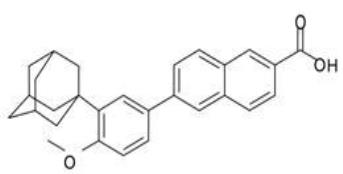
Molecular formula: C28H28O3 Molecular weight: 412.5
Benzoyl peroxide is a highly lipophilic oxidizing agent that localizes in both bacterial and keratinocyte cell membranes. The chemical name for benzoyl peroxide is dibenzoyl peroxide. It has the following structural formula:
Benzoyl Peroxide:

Molecular formula: C14H10O4 Molecular weight: 242.23
Adapalene and benzoyl peroxide topical gel contains the following inactive ingredients: acrylamide/sodium acryloyldimethyltaurate copolymer, docusate sodium, edetate disodium, glycerin, isohexadecane, poloxamer 124, polysorbate 80, propylene glycol, purified water and sorbitan oleate.
-
12 CLINICAL PHARMACOLOGY
12.1 Mechanism of Action
Adapalene binds to specific retinoic acid nuclear receptors but does not bind to cytosolic receptor protein. Biochemical and pharmacological profile studies have demonstrated that adapalene is a modulator of cellular differentiation, keratinization and inflammatory processes. However, the significance of these findings with regard to the mechanism of action of adapalene for the treatment of acne is unknown.
Benzoyl peroxide
Benzoyl peroxide is an oxidizing agent with bactericidal and keratolytic effects.
12.3 Pharmacokinetics
A pharmacokinetic trial was conducted in 26 adult and adolescent subjects (12 to 33 years of age) with severe acne vulgaris who were treated with once-daily applications during a 4-week period with, on average, 2.3 grams/day (range1.6 - 3.1 grams/day) of adapalene and benzoyl peroxide topical gel applied as a thin layer to the face, shoulders, upper chest, and upper back. After a 4-week treatment, 16 subjects (62%) had quantifiable adapalene plasma concentrations above the limit of quantification of 0.1 ng/mL, with a mean Cmax of 0.16 ± 0.08 ng/mL and a mean AUC0 - 24hr of 2.49 ± 1.21 ng.h/mL. The most exposed subject had adapalene Cmax and AUC0 - 24hr of 0.35 ng/mL and 6.41 ng.h/mL, respectively. Excretion of adapalene appears to be primarily by the biliary route. Benzoyl peroxide is absorbed by the skin where it is converted to benzoic acid and eliminated in the urine.
Drug Interactions
No formal drug-drug interaction studies were conducted with adapalene and benzoyl peroxide topical gel.
-
13 NONCLINICAL TOXICOLOGY
13.1 Carcinogenesis, Mutagenesis, Impairment of Fertility
No carcinogenicity, genotoxicity, or fertility studies were conducted with adapalene and benzoyl peroxide topical gel.
Carcinogenicity studies with adapalene were conducted in mice at topical doses of 0.4, 1.3, and 4.0 mg/kg/day (1.2, 3.9, and 12 mg/m2/day) and in rats at oral doses of 0.15, 0.5, and 1.5 mg/kg/day (0.9, 3.0, and 9.0 mg/m2/day). The highest dose levels are 3.2 (mice) and 2.4 (rats) times the MRHD of adapalene and benzoyl peroxide topical gel based on a mg/m2 comparison. In the rat study, an increased incidence of benign and malignant pheochromocytomas reported in the adrenal medulla of male rats was observed.
No significant increase in tumor formation was observed in rodents topically treated with 15 to 25% benzoyl peroxide carbopol gel (6 to 10 times the concentration of benzoyl peroxide in adapalene and benzoyl peroxide topical gel) for two years. Rats received maximum daily applications of 138 (males) and 205 (females) mg/kg benzoyl peroxide (27 to 40 times the MRHD based on a mg/m2 comparison). Similar results were obtained in mice topically treated with 25% benzoyl peroxide carbopol gel for 56 weeks followed by intermittent treatment with 15% benzoyl peroxide carbopol gel for rest of the 2 year study period, and in mice topically treated with 5% benzoyl peroxide carbopol gel for two years.
Benzoyl peroxide is a tumor promoter in several animal species. The significance of this finding in humans is unknown.
Adapalene was not mutagenic or genotoxic in vitro (Ames test, Chinese hamster ovary cell assay, or mouse lymphoma TK assay) or in vivo (mouse micronucleus test).
Benzoyl peroxide caused DNA strand breaks and DNA-protein cross-links in mammalian cells, increased sister chromatid exchanges in Chinese hamster ovary cells, and was mutagenic in a few, but not all, in vitro bacterial mutagenicity assays (Ames tests) conducted.
In rat oral studies, 20 mg/kg/day adapalene (32 times the MRHD based on a mg/m2 comparison) did not affect the reproductive performance and fertility of F0 males and females or the growth, development, or reproductive function of F1 offspring.
No fertility studies were conducted with benzoyl peroxide.
-
14 CLINICAL STUDIES
The safety and efficacy of adapalene and benzoyl peroxide topical gel applied once daily for 12 weeks for the treatment of acne vulgaris were assessed in a multicenter, randomized, double-blind, vehicle-controlled trial, comparing adapalene and benzoyl peroxide topical gel to vehicle gel in subjects with acne vulgaris. The trial also evaluated adapalene and benzoyl peroxide gel, 0.1%/2.5%, a lower strength product than adapalene and benzoyl peroxide topical gel, 0.3%/2.5%. In this trial, 217 subjects were treated with adapalene and benzoyl peroxide topical gel, 217 subjects with adapalene and benzoyl peroxide, gel, 0.1%/2.5% and 69 subjects with the vehicle gel.
Treatment response was defined as the percent of subjects who were rated "clear" or "almost clear' at Week 12 with at least a two-grade improvement based on the Investigator's Global Assessment (IGA), and mean absolute change from baseline at Week 12 in both inflammatory and non-inflammatory lesion counts. An IGA score of 'Clear' corresponded to clear skin with no inflammatory or non-inflammatory lesions. An IGA score of "almost clear" corresponded to a few scattered comedones and a few small papules.
At baseline, 50% of subjects were graded as "moderate" (IGA Grade 3) and 50% were graded as "severe" (IGA Grade 4) on the IGA scale. Subjects had an average of 98 (range 51-226) total lesions of which the mean number of inflammatory lesions was 38 (range: 20-99) and the mean number of non-inflammatory lesions was 60 (range 30-149). Subjects ranged in age from 12 to 57 years, with 273 (54%) of subjects 12 to 17 years of age. Approximately equal number of males (48%) and females (52%) were enrolled.
The IGA success rate, mean reduction, and percent reduction in acne lesion counts from baseline after 12 weeks of treatment are presented in the following table.
Table 3. Clinical Efficacy of Adapalene and Benzoyl Peroxide Topical Gel, 0.3%/2.5% at Week 12 in Subjects with Acne Vulgaris * This This trial was not designed or powered to compare the efficacy of adapalene and benzoyl peroxide topical gel to the lower strength adapalene and benzoyl peroxide gel, 0.1%/2.5%, nor to compare the lower strength adapalene and benzoyl peroxide gel, 0.1%/2.5% to the vehicle control.
Adapalene and Benzoyl Peroxide Topical Gel, 0.3%/2.5% (N=217)
Adapalene and Benzoyl Peroxide Gel,
0.1%/2.5%
(N=217)*
Vehicle
(N=69)
IGA: two-grade improvement and "clear" or "almost clear"
33.7%
27.3%
11.0%
Inflammatory lesions: mean absolute (percent) reduction
27.8 (68.7%)
26.5 (69.3%)
13.2 (39.2%)
Non-inflammatory lesions: mean absolute (percent) reduction
40.5 (68.3%)
40.0 (68.0%)
19.7 (37.4%)
In subjects graded as "severe" (IGA Grade 4), efficacy was observed in the adapalene and benzoyl peroxide topical gel, 0.3%/2.5% group.
- 16 HOW SUPPLIED/STORAGE AND HANDLING
-
17 PATIENT COUNSELING INFORMATION
Advise the patient to read the FDA approved patient labeling (Patient Information).
Hypersensitivity
Inform patients that serious hypersensitivity reactions occurred with the use of benzoyl peroxide products. If a patient experiences a serious hypersensitivity reaction, instruct patient to discontinue adapalene and benzoyl peroxide topical gel immediately and seek medical help [see Warnings and Precautions (5.1)].
Photosensitivity
Advise patients to minimize or avoid exposure to natural or artificial light, including tanning beds or UVA/B treatment. Recommend the use of broad spectrum sunscreen products and protective apparel (e.g., hat) when exposure cannot be avoided [see Warnings and Precautions (5.2)].
Skin Irritation/Contact Dermatitis
Inform patients that adapalene and benzoyl peroxide topical gel may cause irritation such as erythema, scaling, dryness, stinging or burning [see Warnings and Precautions (5.3)].
Lactation
Use adapalene and benzoyl peroxide topical gel on the smallest part of the skin and for the shortest duration possible while breastfeeding. Advise breastfeeding women not to apply adapalene and benzoyl peroxide topical gel directly to the nipple and areola to avoid direct infant exposure [see Use in Specific Populations (8.2)].
Administration Instructions
- Advise patients to cleanse the area to be treated with a mild or soapless cleanser; pat dry. Apply adapalene and benzoyl peroxide topical gel as a thin layer, avoiding the eyes, lips and mucous membranes.
- Advise patients not to use more than the recommended amount and not to apply more than once daily as this will not produce faster results, but may increase irritation.
- Wash hands after application as adapalene and benzoyl peroxide topical gel may bleach hair and colored fabric.
Alembic Pharmaceuticals, Inc.
Bedminster, NJ 07921, USA
Manufactured by:
Alembic Pharmaceuticals Limited
(Derma Division),
Karakhadi, Vadodara 391450, India.
Mfg. License No.: G/25/2216
Patient Information
Adapalene (a dap' a leen) and Benzoyl Peroxide (BEN-zoe-il per-OX-ide)
Topical Gel
Important information: Adapalene and benzoyl peroxide topical gel is for use on the skin only (topical). Do not use adapalene and benzoyl peroxide topical gel in or on your mouth, eyes, or vagina.
What is adapalene and benzoyl peroxide topical gel?
Adapalene and benzoyl peroxide topical gel is a prescription medicine used on the skin (topical) to treat acne vulgaris.
It is not known if adapalene and benzoyl peroxide topical gel is safe and effective in children under 12 years of age.
Do not use adapalene and benzoyl peroxide topical gel if you have had an allergic reaction to benzoyl peroxide or any of the ingredients in adapalene and benzoyl peroxide topical gel. See the end of this Patient Information leaflet for a complete list of ingredients in adapalene and benzoyl peroxide topical gel.
Before using adapalene and benzoyl peroxide topical gel, tell your doctor about all of your medical conditions, including if you:
- have other skin problems, including cuts, abrasions, sunburn or eczema.
- are pregnant or plan to become pregnant. It is not known if adapalene and benzoyl peroxide topical gel can harm your unborn baby.
- are breastfeeding or plan to breastfeed. It is not known if adapalene and benzoyl peroxide topical gel passes into your breast milk and if it can harm your baby. Talk to your doctor about the best way to feed your baby if you use adapalene and benzoyl peroxide topical gel. If you use adapalene and benzoyl peroxide topical gel while breastfeeding, use adapalene and benzoyl peroxide topical gel on the smallest area of the skin and for the shortest time needed. Do not apply adapalene and benzoyl peroxide topical gel directly to the nipple and the areola to minimize contact with your baby.
How should I use adapalene and benzoyl peroxide topical gel?
- Use adapalene and benzoyl peroxide topical gel exactly as your doctor tells you to use it.
- Apply adapalene and benzoyl peroxide topical gel 1 time a day.
- Do not use more adapalene and benzoyl peroxide topical gel than you need to cover the treatment area. Using too much adapalene and benzoyl peroxide topical gel or using it more than 1 time a day may increase your chance of skin irritation.
- Wash the area where the gel will be applied with a mild or soapless cleanser and pat dry.
- Adapalene and benzoyl peroxide topical gel comes in a pump. Depress the pump to dispense a small amount (about the size of a pea) of adapalene and benzoyl peroxide topical gel and spread a thin layer over the treatment area. Use a pea-sized amount for each area of the face (forehead, chin, and each cheek).
- Wash your hands right away after applying the gel. Adapalene and benzoyl peroxide topical gel may bleach your hair or colored fabrics. Allow adapalene and benzoyl peroxide topical gel to dry completely before dressing to prevent bleaching of your clothes.
What should I avoid while using adapalene and benzoyl peroxide topical gel?
- Avoid spending time in sunlight or artificial sunlight, such as tanning beds or sunlamps. Adapalene and benzoyl peroxide topical gel can make your skin sensitive to sun and the light from tanning beds and sunlamps. Use sunscreen and wear a hat and clothes that cover the areas treated with adapalene and benzoyl peroxide topical gel if you have to be in sunlight.
- Cold weather and wind may irritate skin treated with adapalene and benzoyl peroxide topical gel.
- Avoid applying adapalene and benzoyl peroxide topical gel to cuts, abrasions, and sunburned skin.
- Avoid skin products that may dry or irritate your skin such as medicated or harsh soaps, astringents, cosmetics that make your skin dry, and products containing high levels of alcohol, spices, or limes.
- Avoid the use of "waxing" as a hair removal method on skin treated with adapalene and benzoyl peroxide topical gel.
What are the possible side effects of adapalene and benzoyl peroxide topical gel?
Adapalene and benzoyl peroxide topical gel may cause serious side effects including:
- Allergic reactions. Stop using adapalene and benzoyl peroxide topical gel and get medical help right away if you have any of the following symptoms during treatment with adapalene and benzoyl peroxide topical gel:
○ swelling of your face, eyes, lips, tongue, or throat
○ trouble breathing or throat tightness
○ feeling faint, dizzy, or lightheaded
- Skin Irritation. Skin irritation is common with adapalene and benzoyl peroxide topical gel and is most likely to happen during the first 4 weeks of treatment, and usually lessen with continued use of adapalene and benzoyl peroxide topical gel. Skin reactions at the treatment area include redness, scaling, dryness, stinging, burning, itching and swelling. Tell your doctor if you get any skin reactions.
- Sensitivity to sunlight. See "What should I avoid while using adapalene and benzoyl peroxide topical gel ?"
Call your doctor for medical advice about side effects. You may report side effects to FDA at 1-800-FDA-1088.
How should I store adapalene and benzoyl peroxide topical gel?
- Store adapalene and benzoyl peroxide topical gel at room temperature between 68°F to 77°F (20°C to 25°C).
- Keep adapalene and benzoyl peroxide topical gel out of light and away from heat.
General information about the safe and effective use of adapalene and benzoyl peroxide topical gel
Medicines are sometimes prescribed for purposes other than those listed in a Patient Information leaflet. Do not use adapalene and benzoyl peroxide topical gel for a condition for which it was not prescribed. Do not give adapalene and benzoyl peroxide topical gel to other people, even if they have the same symptoms you have. It may harm them. You can ask your doctor or pharmacist for information about adapalene and benzoyl peroxide topical gel that is written for health professionals.
What are the ingredients in adapalene and benzoyl peroxide topical gel?
Active ingredient: adapalene and benzoyl peroxide
Inactive ingredients: acrylamide/sodium acryloyldimethyltaurate copolymer, docusate sodium, edetate disodium, glycerin, isohexadecane, polaxamer 124, polysorbate 80, propylene glycol, purified water and sorbitan oleate.
Manufactured for:
Alembic Pharmaceuticals, Inc.
Bedminster, NJ 07921, USA
Manufactured by:
Alembic Pharmaceuticals Limited
(Derma Division),
Karakhadi, Vadodara 391450, India.
Mfg. License No.: G/25/2216
For more information, call Alembic Pharmaceuticals, Inc. at 1-866-210-9797.
This Patient Information has been approved by the U.S. Food and Drug Administration. Revised: 12/2023
- PATIENT PACKAGE INSERT
-
PACKAGE LABEL.PRINCIPAL DISPLAY PANEL
Adapalene and Benzoyl Peroxide Topical Gel 0.3%/2.5%
PUMP
FOR TOPICAL USE ONLY
45 grams
Alembic Pharmaceuticals, Inc.
For topical use only. Not for ophthalmic, oral or intravaginal use.
Usual dosage: Apply a thin layer once a day to affected areas. See package insert for complete prescribing information.
Each gram contains: Active: adapalene 0.3% and benzoyl peroxide 2.5% in a gel.
Inactive: acrylamide/sodium acryloyldimethyltaurate copolymer, docusate sodium, edetate disodium, glycerin, isohexadecane, poloxamer 124, polysorbate 80, propylene glycol, purified water and sorbitan oleate.
Storage: Store at 20° to 25°C (68° to 77°F); excursions permitted between 15° to 30°C (59° to 86°F) [see USP Controlled Room Temperature].
See carton closure for lot number and expiry date.
Manufactured for:
Alembic Pharmaceuticals, Inc.
Bedminster, NJ 07921, USA
Manufactured by:
Alembic Pharmaceuticals Limited
(Derma Division),
Karakhadi, Vadodara 391450, India.
Mfg. License No.: G/25/2216
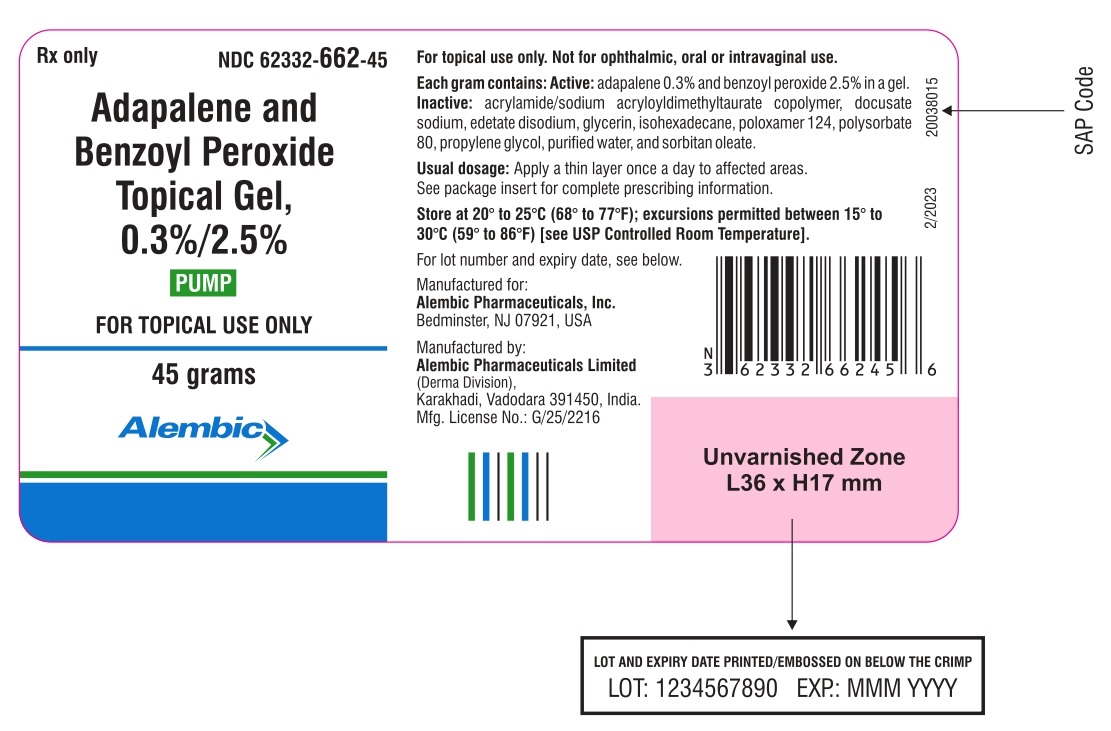
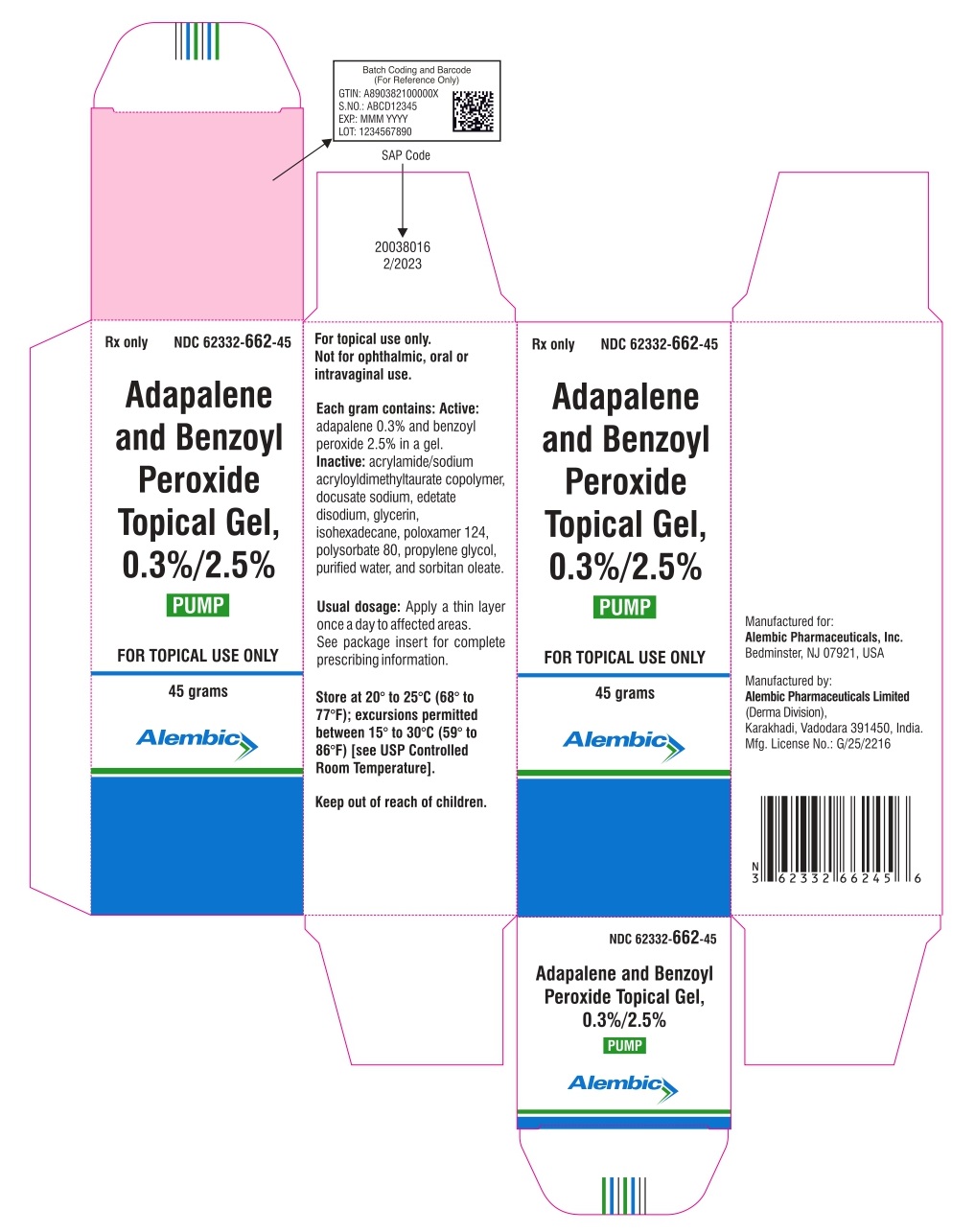
-
INGREDIENTS AND APPEARANCE
ADAPALENE AND BENZOYL PEROXIDE
adapalene and benzoyl peroxide topical gelProduct Information Product Type HUMAN PRESCRIPTION DRUG Item Code (Source) NDC:62332-662 Route of Administration TOPICAL Active Ingredient/Active Moiety Ingredient Name Basis of Strength Strength ADAPALENE (UNII: 1L4806J2QF) (ADAPALENE - UNII:1L4806J2QF) ADAPALENE 3 mg in 1 g BENZOYL PEROXIDE (UNII: W9WZN9A0GM) (BENZOYL PEROXIDE - UNII:W9WZN9A0GM) BENZOYL PEROXIDE 25 mg in 1 g Inactive Ingredients Ingredient Name Strength ACRYLIC ACID/SODIUM ACRYLATE COPOLYMER (1:1; 600 MPA.S AT 0.2%) (UNII: M4PPW69Y4H) DOCUSATE SODIUM (UNII: F05Q2T2JA0) EDETATE DISODIUM (UNII: 7FLD91C86K) GLYCERIN (UNII: PDC6A3C0OX) ISOHEXADECANE (UNII: 918X1OUF1E) POLOXAMER 124 (UNII: 1S66E28KXA) POLYSORBATE 80 (UNII: 6OZP39ZG8H) PROPYLENE GLYCOL (UNII: 6DC9Q167V3) WATER (UNII: 059QF0KO0R) SORBITAN MONOOLEATE (UNII: 06XEA2VD56) Packaging # Item Code Package Description Marketing Start Date Marketing End Date 1 NDC:62332-662-45 1 in 1 CARTON 08/10/2022 1 45 g in 1 BOTTLE, PUMP; Type 0: Not a Combination Product Marketing Information Marketing Category Application Number or Monograph Citation Marketing Start Date Marketing End Date ANDA ANDA214185 08/10/2022 Labeler - Alembic Pharmaceuticals Inc. (079288842) Registrant - Alembic Pharmaceuticals Limited (650574663) Establishment Name Address ID/FEI Business Operations Alembic Pharmaceuticals Limited 871411532 MANUFACTURE(62332-662) , ANALYSIS(62332-662)

